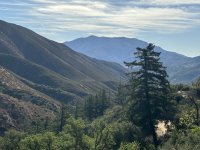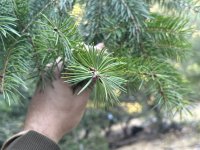Cruiser
Chumono
A cousin to that other pseudotsuga we know and love (menziesii). Macrocarpa is better adapted to arid conditions and wildfire.
It has a small range in Southern California, where it frequents chaparral and dry woodlands.
Macrocarpa grows in scattered patches or as lone individuals. It does not form a ubiquitous overstory, like menziesii.

Long straight branches coated with foliage set its silhouette apart from associates.

Needles, bark, and buds are similar to menziesii.


Cones are bigger and woodier than menziesii. Seeds are larger with shorter wings.


Macrocarpa is thought to have a close relationship with oaks and may be reliant on them early in life. An oak over-story helps shelter establishing trees from excessive heat and drought; and relative to other chaparral species, provides a less-combustible buffer to fire.
An interesting feature of bigcone Douglas-fir is the ability for it to vigorously re-sprout from trunk and branches following complete needle loss. (eg after a wildfire) This seems like a useful ability one could manipulate for bonsai purposes..
Of 14 collected cones: 4 came fresh from branches. The rest were found on the ground, partially ripped open by birds and squirrels looking for a meal.
228 viable-looking seeds were obtained. Many more disfigured or damaged seeds were tossed. The best cone contained around 50 keepers.



The plan is to divide the seeds and try different strategies for germination. Some will get planted now to over winter outside, others will be stored in a freezer, fridge, or at room temp, then planted in spring.
It has a small range in Southern California, where it frequents chaparral and dry woodlands.
Macrocarpa grows in scattered patches or as lone individuals. It does not form a ubiquitous overstory, like menziesii.

Long straight branches coated with foliage set its silhouette apart from associates.

Needles, bark, and buds are similar to menziesii.


Cones are bigger and woodier than menziesii. Seeds are larger with shorter wings.


Macrocarpa is thought to have a close relationship with oaks and may be reliant on them early in life. An oak over-story helps shelter establishing trees from excessive heat and drought; and relative to other chaparral species, provides a less-combustible buffer to fire.

An interesting feature of bigcone Douglas-fir is the ability for it to vigorously re-sprout from trunk and branches following complete needle loss. (eg after a wildfire) This seems like a useful ability one could manipulate for bonsai purposes..
Of 14 collected cones: 4 came fresh from branches. The rest were found on the ground, partially ripped open by birds and squirrels looking for a meal.
228 viable-looking seeds were obtained. Many more disfigured or damaged seeds were tossed. The best cone contained around 50 keepers.



The plan is to divide the seeds and try different strategies for germination. Some will get planted now to over winter outside, others will be stored in a freezer, fridge, or at room temp, then planted in spring.
Attachments
Last edited:

